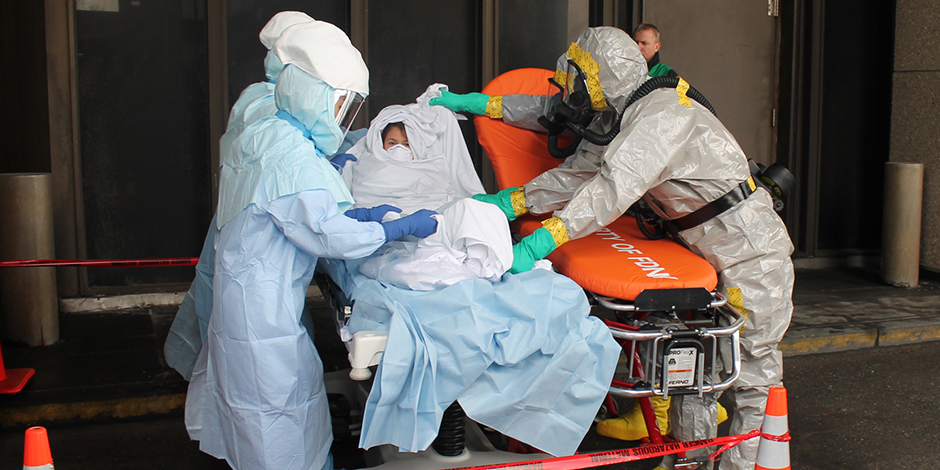NYC Health + Hospitals Leads Multi-Site, Multi-Agency Drill on Infectious Special Pathogens
Real-world simulation assesses New York City's readiness to care for patients with Lassa fever and MERS
Apr 05, 2017

Today, NYC Health + Hospitals led a citywide full-scale special pathogens exercise to assess New York City’s readiness to care for patients with contagious and potentially lethal illnesses. NYC Health + Hospitals partnered with the New York City Department of Health and Mental Hygiene, the Fire Department of New York, the Office of Chief Medical Examiner, New York City Office of Emergency Management, and New York State Department of Health for the daylong interactive training.
The exercise mimicked a real-life response, allowing participants to develop the strategic skills necessary to keep the public safe in the event of an actual special pathogens exposure. Medical professionals from three care sites—NYC Health + Hospitals/Bellevue, NYC Health + Hospitals/Elmhurst, and NYC Health + Hospitals/Gotham Health, Morrisania—were challenged with identifying and treating two patients with symptoms of Lassa fever and Middle Eastern Respiratory Syndrome (MERS-CoV) that they didn’t know to expect. As an additional component of the exercise, the health system’s Central Office Emergency Management was tasked with coordinating the care provision and keeping things safe. The Fire Department managed the emergency transportation of the mock patients, one of whom “dies” and is subsequently handled by the Office of the Chief Medical Examiner.
“The scope and complexity of today’s exercise gave participants an added layer of realism,” said Stanley Brezenoff, interim president and chief executive officer of NYC Health + Hospitals. “This type of hands-on exercise empowers clinicians to act from a position of strength if they ever encounter a real-life special pathogens exposure.”
The exercise focused on two simulated patients, siblings who traveled to West Africa and the Middle East as public health students. One day after their return to New York City, the siblings presented separately to NYC Health + Hospitals/Elmhurst and NYC Health + Hospitals/Gotham Health, Morrisania with symptoms of special pathogens exposure. During the exercise, the siblings were portrayed by professional actors, and then by mannequins once the scenario advanced to an inpatient setting at NYC Health + Hospitals/Bellevue. The drill included the handoff of a patient from the Fire Department to the Special Pathogens Program staff at NYC Health + Hospitals/Bellevue. Goals included assessing emergency protocols and communication skills and reminding participants of the importance of taking patient travel histories.
During the exercise, clinicians wore personal protective equipment (often referred to as PPE), while caring for the simulated patients. “Wearing PPE and several layers of gloves makes performing routine medical procedures more difficult,” said Machelle Allen, MD, NYC Health + Hospitals Chief Medical Officer. “By working through these challenges during a simulation, we improve the likelihood of our getting everything right in the event of a real special pathogens exposure.”
The event included regional, national, and international observers from such organizations as the Centers for Disease Control and Prevention, the U.S. Department of Health and Human Services, the U.S. Department of Veterans Affairs, the Office of the Assistant Secretary for Preparedness and Response, the National Ebola Training and Education Center, Emory University, University of Nebraska Medical Center, Greater New York Hospital Association, and the Royal Free London National Health Service Foundation Trust.
“This is one of the most complex drills that we have ever undertaken,” said Syra S. Madad, DHSc, MSc, MCP, director of the System-wide Special Pathogens Program at NYC Health + Hospitals. “Involving multiple city and state agencies and beginning with identification in a clinical setting by providers who don’t know to expect this are two of the reasons that national and international observers are coming to watch and learn.”